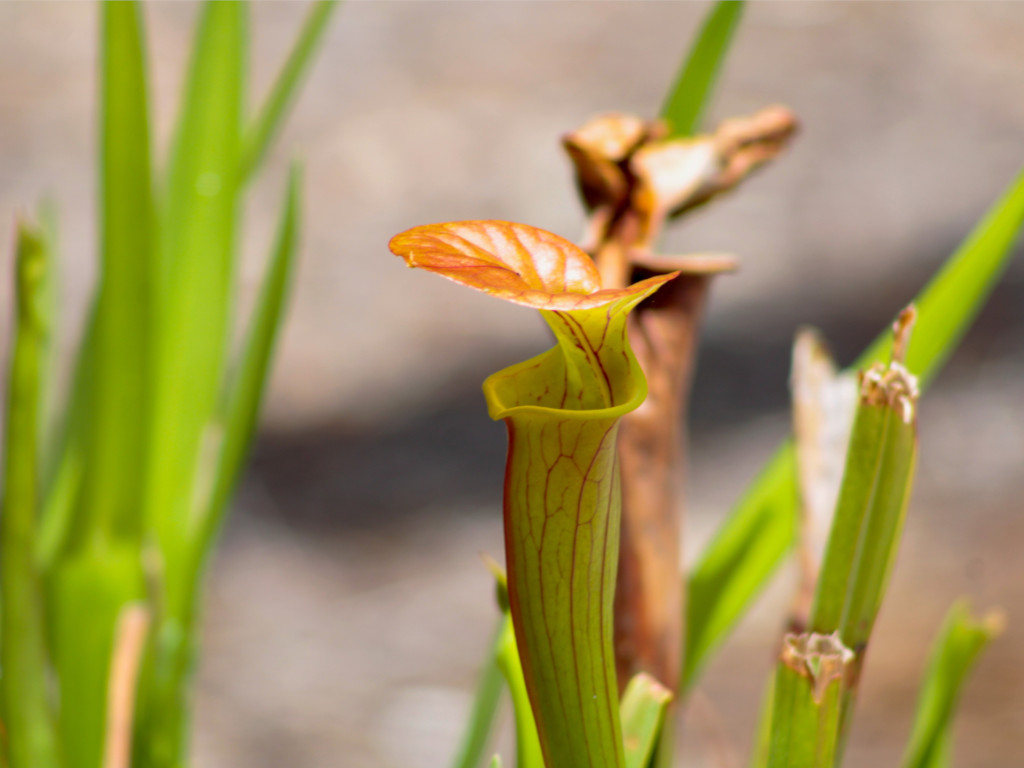Carnivorous plants are found all over the world in many different climates, and some will grow very well outside in the UK. If you just want to keep them outside in the summer, or can give a little protection with a cloche or cold frame, then most Trumpet Pitchers, Venus Flytraps and many Sundews will be fine.
You can keep them outside all the time even in winter, without protection. The plants that make the best display are the Trumpet Pitchers (Sarracenias). Not all will do well, but if you choose the right species and hybrids you can have a fantastic display of flowers followed by the lovely traps. On a smaller scale, there are some native sundews and butterworts which grow naturally in the boggy ground around the UK.
What to plant
The plants that will do well outside are on the Outdoor Carnivorous Plants section of the website. Do give the plants room to grow. It is best to stick to just carnivorous plants. Don’t be tempted to add ornamental grasses or flowering plants for extra interest. They will compete with the carnivorous plants and are likely to take over. As a guide, our large hardy collection would be fine for a belfast sink. The plants that do best are the early season plants, such as the Yellow Trumpet (Sarracenia flava), the Mountain Pitcher (Sarracenia oreophila) and the hardiest of all, the Huntsmans Cap (Sarracenia purpurea). In fact, the Huntsmans Cap grows far better outside than it does in our polytunnel. It may be because when kept naturally, the traps will fill with water and this help attract flies and insects. All carnivorous plants will catch more outside and this is a definite boost to their growth.There are many hybrids that give a good variety of size shape and colour. Sarracenia x harperi is and excellent choice – vigorous and sturdy. Choose shorter plants if you think your site may catch the wind or will not get the sun all day. For best growth and colour you do need full sun, but if you have semi shade then you can grow the Huntmans Cap and Sarracenia x catesbaei, Butterwort (Pinguicula grandiflora) and even try the Cobra Lily (Darlingtonia californica).
Smaller plants are the hardy Sundews (need full sun) and the hardy Butterwort (semi-shade), but they are on a completely different scale to the Trumpet Pitchers. They do still make a fascinating display. The container for these can be quite small, and shallow – a terracotta or plastic bowl. They are not usually vigorous plants so weeding is essential to keep out unwanted grasses etc.
Where to plant
A position in full sun, sheltered from the wind will get the best results for the majority of plants and it is particularly true for the taller plants. If you have semi shade it will cut down the number of suitable plants but with the right choice, you will still get a good display. Some of the colours may not be as intense.There are several ways to grow these plants in your garden:
1. Container.
The simplest way is to make a mini bog. This is basically a container that holds water, filled with suitable compost.
The container should either have no holes or you can line it with thick polythene to around 2/3rds up the side to hold water. It should not be made of concrete or limestone.(because of the lime). An old belfast sink with the plug in, oak barrel or glazed terracotta pot all work well. it can be any size from a washing up bowl upwards, but the larger the container the more self-sufficient it will be.
2. Pond
Another place to keep them is in a pond ?even less to do as they will have a constant supply of water. However, they are bog plants and not marginal plants so the water should be no more than 2/3rds up the side of the pot. Again, full sun will be best.
3. Bog Garden.
For a more naturalistic effect you can make a bog garden by digging out the area to a depth of 150 – 300mm (6-12″) and lining with some thick polythene. You can also plunge eg half a dustbin in the ground – make some holes 2/3rds up to allow for some drainage. As long as the compost is carnivorous plant compost, the plants should do well. If making a carnivorous section of an existing bog garden, we would recommend making a separate area as the compost used for usual bog plants will be too rich and limey for these plants.
Please also be aware a natural stream may be suitable, but if your stream comes over limestone or the soil is not acidic, you are best to line the area and use the correct compost. Any stream needs to keep running over the whole of the summer to be OK for bog plants ? though obviously it will be less wet in summer.
Compost
Any carnivorous plant compost will be fine, even pure moss peat, though a bit of lime free sharp sand will give extra body. Trumpet Pitcher compost does contain Perlite ? the small white balls, which can look a little unsightly at first but soon blend in. The way to calculate how much you need is to work out the volume. Compost is measured in litres so you can just see how much water it will hold. Fill the container to 50mm (2″) below the top. This makes watering easier. Another aid to watering is a length of plastic pipe sitting vertically in the container 50mm (22) from the bottom. It should finish just proud of the compost and can then be used to water and to check the water level in the container. Evaporation can be reduced by mulching with good quality pine bark.Planting
Plants that are potted can be planted at any time but March and April are ideal. The plants are just coming into growth and you should get the full growing season of flowers then traps.Allow space to grow particularly for the Huntsmans Cap. Most large Sarracenias should be planted 20-30cm apart. Sundews should be planted quite close – 10cm apart. If growing Trumpet pitchers and Sundews in the same container, give plenty of space around the Sundews as Trumpets can quickly overshadow them. It may be easier to grow them separately.
Maintenance
As bog plants, they will need watering, but how much will depend on the weather. There can be quite a bit of evaporation from the soil and it is important they don’t dry out too much. As they grow they will start to cover the ground and moss will grow over the surface, reducing the need to water. A larger the container will need watering less often.In winter, they will not mind being very wet but if you haven’t allowed for drainage up the side of the pot – difficult with a belfast sink, then just tilt on edge on a brick so excess water can flow off. It is not necessary to provide frost protection unless you are growing slightly less hardy plants – Venus Flytrap for instance.
Weeding is important. Grasses, ferns and other weeds will quickly take over. Other maintenance will be cutting off dead growth and generally keeping tidy. Feeding will not be necessary. The traps will be stuffed with flies.

